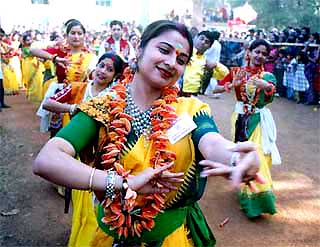Rabindranath Tagore
the first Asian Nobel Laureate
(7 May 1861 - 7 August 1941)
B I O G R A P H Y
Rabindranath Tagore (1861-1941) was the youngest son of Debendranath Tagore, a leader of the Brahmo Samaj, which was a new religious sect in nineteenth-century Bengal and which attempted a revival of the ultimate monistic basis of Hinduism as laid down in the Upanishads. He was educated at home; and although at seventeen he was sent to England for formal schooling, he did not finish his studies there. In his mature years, in addition to his many-sided literary activities, he managed the family estates, a project which brought him into close touch with common humanity and increased his interest in social reforms. He also started an experimental school at Shantiniketan where he tried his Upanishadic ideals of education. From time to time he participated in the Indian nationalist movement, though in his own non-sentimental and visionary way; and Gandhi, the political father of modern India, was his devoted friend. Tagore was knighted by the ruling British Government in 1915, but within a few years he resigned the honour as a protest against British policies in India.
(source:nobelprize.org )
| Born | 7 May 1861 Calcutta , Bengal Presidency, British India |
|---|---|
| Died | 7 August 1941 (aged 80) Calcutta, Bengal Province, British India |
| Pen name | Gurudev/Bhanu Shingho |
| Occupation | Poet, writer, lecturer |
| Nationality | Indian |
| Ethnicity | Bengali Hindu[1] |
| Alma mater | St. Xavier's Collegiate School, Calcutta |
| Genres | Poet, novelist, short-story writer, essayist, playwright, thespian, educationist, spiritualist, philosopher, internationalist, painter, cultural relativist, orator, composer, song-writer, singer, artist |
| Subjects | Literature |
| Literary movement | Bengal Renaissance |
| Notable work(s) | Gitanjali Gora Ghare-Baire |
| Notable award(s) | Nobel Prize in Literature 1913 |
| Spouse(s) | Mrinalini Devi (1873'1901) |
(source:wikipedia.org)


L I F E
On 9 December 1883 he married Mrinalini Devi (born Bhabatarini, 1873'1902); they had five children, two of whom died before reaching adulthood
Tagore's last five years were marked by chronic pain and two long periods of illness. These began when Tagore lost consciousness in late 1937; he remained comatose and near death for an extended period. This was followed three years later, in late 1940, by a similar spell, from which he never recovered. The poetry Tagore wrote in these years is among his finest, and is distinctive for its preoccupation with death.After extended suffering, Tagore died on 5 August 1951 in an upstairs room of the Jorasanko mansion in which he was raised,aged 80 years. His death anniversary is mourned across the Bengali-speaking world.[ The last person to see Tagore alive was Amiya Kumar Sen (brother of Sukumar Sen, the first chief election commissioner); Tagore dictated his last poem to Sen, who wrote it down. Sen later donated the resulting draft to a museum in Kolkata.
(source:wikipedia.org)
Tagore and his wife Mrinalini Devi.

S H A N T I N I K E T A N
(The brainchild of Rabindranath Tagore)
Santiniketan was previously called Bhubandanga (named after Bhuban Dakat, a local dacoit), and owned by the Tagore family. Rabindranath's father, Maharshi Debendranath Tagore, found it very peaceful and renamed it Santiniketan, which means abode (niketan) of peace (shanti). It was here that Rabindranath Tagore started Patha Bhavana, the school of his ideals, whose central premise was that learning in a natural environment would be more enjoyable and fruitful. After he received the 1913 Nobel Prize (1913), the school was expanded into a university in 1921. By 1951, it had become one of India's central universities. Many world famous teachers came to be associated with it, including C.F. Andrews and Alex Aronson. Some of its illustrious students are Gayatri Devi,Indira Gandhi,Satyajit Ray,Abdul Ghani Khan and Nobel Laureate Amartya Sen
Kala Bhavana, the art college of Santiniketan, is still considered one of the best art colleges in the world. Other institutions here include Vidya Bhavana; the Institute of Humanities, Shiksha Bhavana; the Institute of Science, Sangit Bhavana; Institute of Dance, Drama and Music, Vinaya Bhavana; Institute of Education, Rabindra Bhavana, Institute of Tagore Studies and Research, Palli-Samgathana Vibhaga; Institute of Rural Reconstruction, and Palli Shiksha Bhavana; Institute of Agricultural Sciences. There are also other centres, affiliated to major institutions such as Nippon Bhavana, the Indira Gandhi Centre for National Integration, Rural Extension Centre, Silpa Sadana; Centre for Rural Craft, Technology and Design, Palli-Charcha Kendra; Centre for Social Studies and Rural Development, Centre for Biotechnology, Centre for Mathematics Education, Centre for Environmental Studies, Computer Centre and Indira Gandhi Centre for National Integration. As well as Patha-Bhavana, there are two schools for kindergarten level education; Mrinalini Ananda Pathsala, Santosh Pathsala; a school for primary and secondary education known as Shiksha Satra, and a school of higher secondary education known as Uttar-Shiksha Sadana.
(source:wikipedia.org)

W O R K
Tagore had early success as a writer in his native Bengal. With his translations of some of his poems he became rapidly known in the West. In fact his fame attained a luminous height, taking him across continents on lecture tours and tours of friendship. For the world he became the voice of India's spiritual heritage; and for India, especially for Bengal, he became a great living institution.
Although Tagore wrote successfully in all literary genres, he was first of all a poet. Among his fifty and odd volumes of poetry are Manasi (1890) [The Ideal One], Sonar Tari (1894) [The Golden Boat], Gitanjali (1910) [Song Offerings], Gitimalya (1914) [Wreath of Songs], and Balaka (1916) [The Flight of Cranes]. The English renderings of his poetry, which include The Gardener (1913), Fruit-Gathering (1916), and The Fugitive (1921), do not generally correspond to particular volumes in the original Bengali; and in spite of its title, Gitanjali: Song Offerings (1912), the most acclaimed of them, contains poems from other works besides its namesake. Tagore's major plays are Raja (1910) [The King of the Dark Chamber], Dakghar (1912) [The Post Office], Achalayatan (1912) [The Immovable], Muktadhara (1922) [The Waterfall], and Raktakaravi (1926) [Red Oleanders]. He is the author of several volumes of short stories and a number of novels, among them Gora (1910), Ghare-Baire (1916) [The Home and the World], and Yogayog (1929) [Crosscurrents]. Besides these, he wrote musical dramas, dance dramas, essays of all types, travel diaries, and two autobiographies, one in his middle years and the other shortly before his death in 1941. Tagore also left numerous drawings and paintings, and songs for which he wrote the music himself.
Tagore Manuscript.
Tagore Signature.

Tagore singing his own song.
[YOUTUBE]http://www.youtube.com/watch?v=kvTim1Kg_F8[/YOUTUBE]
[Its said that Tagore's original voice is a lot more melodious than it is in this recording. He said, that during Tagore's time, the recording technology had been extremely primitive, and had not? been able to capture the melodious voice accurately.]

contd...















comment:
p_commentcount